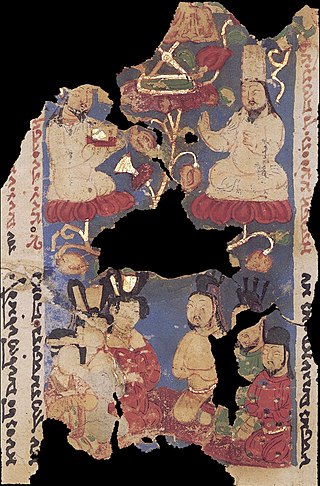Top Qs
Timeline
Chat
Perspective
Leaf from a Manichaean book MIK III 8259
Manichaean Manuscript Fragment From Wikipedia, the free encyclopedia
Remove ads
Leaf from a Manichaean book MIK III 8259 is a fragment of Manichaean manuscripts collected in Germany Berlin Asian Art Museum, drawn during the 8th–9th centuries. It was discovered in Xinjiang by German Turpan expedition team in the early 20th century.[1] It is the largest currently known manuscript fragment, and is also the largest codex fragment with a figural scene, having a large portion of text on the same fragment. There is also text on the reverse of the image.[2]
This article possibly contains original research. (July 2025) |
According to Zsuzsanna Gulácsi's interpretation of the fragment, following Albert von Le Coq, in the bottom segment three laymen and three laywomen of the Uyghur royal family are listening to a sermon, while in the upper section elects are giving a sermon.[1]
Drawing attention to the depiction of a flower in the central part of the fragment, Samuel N. C. Lieu instead interprets the fragment as a visionary scene of penitence in the context of the Manichaean doctrine of the imprisonment of Light in living things: "The fear is so apparent on their [the elects'] faces that von Le Coq's original explanation for the miniature as a didactic scene is grossly inadequate. What we have before us are two Electi terrified at the sight of blood spurting from a damaged plant." At the bottom, "a group of Hearers (who might have been responsible for the crime) in penitential stance completes a doctrinally significant artistic representation."[3]
Remove ads
References
Wikiwand - on
Seamless Wikipedia browsing. On steroids.
Remove ads

